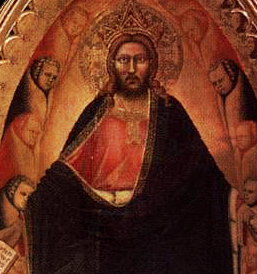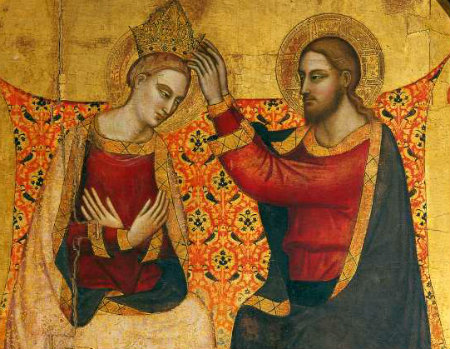Andrea Orcagna
1320-1368
Italian Late Gothic Byzantine Style Painter, Architect, Sculptor, Mosaist and Poet
Influences - Giotto di Bondone Cimabue, Coppo di Marcovaldo
Education - apprenticed to Giotto di Bondone and Andrea Pisano
Painting Medium - Tempera and gilt on wood

Andrea Orcagna was born into a family of artists and craftsmen. His brothers Jacopo and Nardo di Cione were also well known artists. According to Vasari, Orcagna was the leading Florentine artist of his generation and attributed many great works to him, including the altarpiece of The Redeemer with the Madonna and Saints in the Strozzi Chapel. Orcagna survived the great plague of the late 1340s but the consequences of the pandemic influenced his style and themes. The horrors of the black death pervaded all aspects of Medieval culture and especially art. The effects were lasting, bringing a somber darkness to visual art, literature, and music. The dreadful trauma of this era instigated the imaginations of writers and painters in bleak and disturbing ways for decades to follow. Hell, Satan and the Grim Reaper became favored subjects. With an imagery at once, bizarre, fantastic and inspirational, Orcagna invented an ethereal universe of inspiring beauty - an idyllic and shining Kingdome from which evil, hardship and gloom were eternally forbidden. Even the most eccentric of his paintings, are serene and everlasting in their sincerity. Sadly Orcagna's later years were overshadowed by a dramatic decline of his mental state due to his drunken binges. He died relatively young at forty-eight.
Most prominently featured in his work are the holy figures of the Christian faith--the -Christ, Saints, The Cross, Virgin Mary, Chalice, Keys, The Anchor, Wheat , The Good Shepherd, The Apostles, Animals, Fish, Angels, Birds, Insects and Satan.

With
the triumph of Christianity, Byzantine style artists aspired to
reawaken the divine spirit of holy figures rather than depict their
physical qualities. Their unique style is a
combination of frontal simplicity, truth to nature,
harmonious unity together with precision in details. The use
of costly materials such as gold, precious stones and ivory indicates
the degree of wealth that was common during this period, and attests to
the sophistication of the culture.
Eminent art historian and aurthor, Clive Bell explains "Between 900 and
1200 the capital achievements of Christian art are not superior in
quality to those of the preceding age—indeed, they fall short of the
Byzantine masterpieces of the sixth century; but the first-rate art of
this second period was more abundant, or, at any rate, has survived
more successfully, than that of the first. The age that has bequeathed
us Romanesque, Lombardic, and Norman architecture gives no sign of
dissolution. We are still on the level heights of the Christian
Renaissance. Artists are still primitive. Men still feel the
significance of form sufficiently to create it copiously. Increased
wealth purchases increased leisure, and some of that leisure is devoted
to the creation of art. I do not marvel, therefore, at the common,
though I think inexact, opinion that this was the period in which
Christian Europe touched the summit of its spiritual history: its
monuments are everywhere majestic before our eyes."
.
| Byzantine 500-1450 | Romanesque 950-1250 | ||||||||||
| Gothic 1150-1580 | Florentine | ||||||||||
| Sienese School 1150-1550 | Venetian | ||||||||||
| Early Renaissance 1350-1500 | |||||||||||
| High Renaissance 1450-1530 | |||||||||||
| Northern Renaissance 1350-1600 | |||||||||||
| Mannerism 1510-1600 | |||||||||||
| Baroque 1600-1750 | |||||||||||
| Rococo 1710-1790 | |||||||||||
| Neoclassical 1740-1835 | |||||||||||
| Romanticism 1750-1860 | |||||||||||
| Hudson River School 1825-1880 | |||||||||||
| Orientalism 1800-1885 | |||||||||||
| Academic Classicism 1865-1920 | |||||||||||
| Victorian Classicism 1845-1895 | |||||||||||
| Pre-Raphaelite 1840-1855 | |||||||||||
Impressionism
1860-1895
|
Require more information about Cimabue in Art History? Type your query in art into the google search box below and poke around every nook and cranny of the known universe for information this subject.
Do you know something we don't? If you have comment or would like to share an insight regarding Cimabue in Art History, please submit your comment to the editor, via e-mail and if possible site the source. Thank you!
© HistoryofPainters.com If you like this page and wish to share it, you
are welcome to link to it, with our thanks.
| links | artist biographies | top 50 painters | art supplies | book store |
| site map | art movements | artist quotations | iconography | 100 greatest paintings |